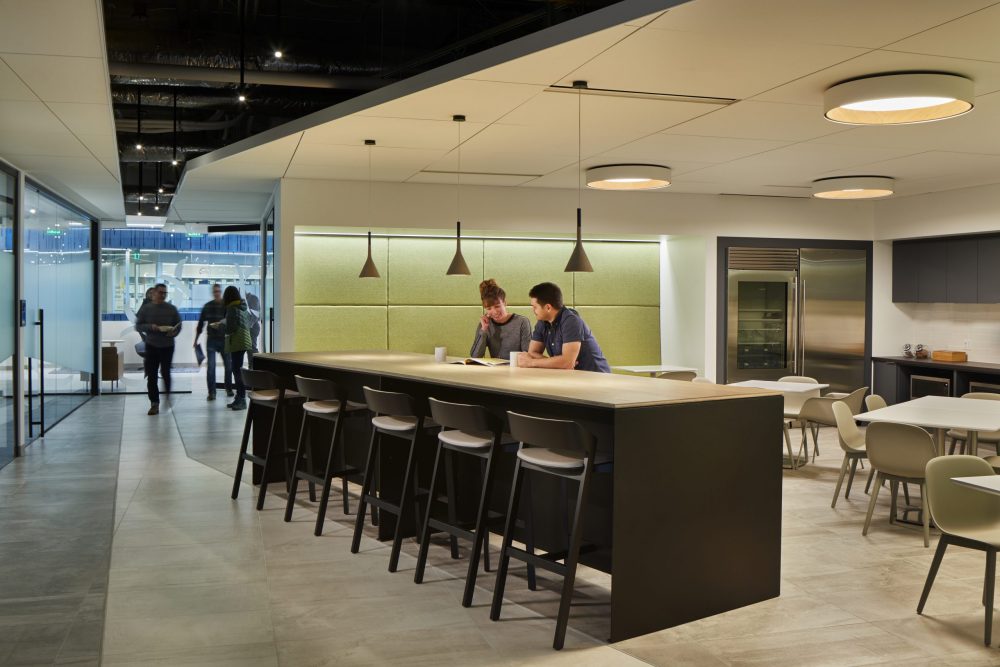Perkins&Will’s Sidney Scarboro shares how companies must maintain their office culture remotely and virtually in the future.

Regardless of whether we are sitting at a kitchen table, desk or on a living room sofa, our COVID-19 commute to work is now often walking up a staircase or ten feet across the room. The pandemic has created a new normal that still requires a physical work environment but is virtual in terms of interactions with clients and colleagues. The spontaneity of casual interactions now requires pre-planning and a calendar invitation. In-person encounters such as sharing ideas, casual conversations, quick coffees or lunches in the kitchen and routine staff gatherings are on hold, for the moment.
Can companies maintain their culture remotely and virtually?
Many are asking: How do we differentiate our company and work? Stay competitive without the ability to gather and discuss ideas? Recruit talent? Inspire, mentor staff and deliver work product? Disconnecting our company culture from the physical office environment is an unexpected challenge, but technology tools have evolved and provided opportunities for accelerating virtual communication abilities. Virtual meeting platforms, immersive virtual reality environments, interactive whiteboards and simple phone calls are the conference rooms of today.
Using our creativity, we have devised new ways of gathering ideas called “design sprints” that capture the fluidity of thinking. Design sprints come from an agile development mindset, created by technology companies for products. The goal is to make good decisions about design that consequentially solve clients’ problems at a faster pace. For example, Perkins&Will recently used design sprints to offer three radically different design ideas in a virtual meeting room and collected first impressions from the designers in less than five minutes.
A new variety of virtual meeting platforms have encouraged sharing of visuals and workers’ home settings. In many ways, using technology to work from home has provided insights into the personalities and values of clients and colleagues. These platforms have inspired creative group activities and expanded the number of meeting participants. Our perceptions have also changed from keeping project teams “local” to inviting a more global group. As a result of intuitive virtual meeting rooms and digital controls, team members from varying parts of the world can seamlessly collaborate on new business proposals, projects and companywide endeavors.
Office culture is the emotional and collective spirit of the team.
While virtual work, with all of its tools, is here to stay for the foreseeable future, recent studies indicate a gradual shift to “hybrid work models” – with some employees working from home part-time and others working from the office part-time. Offices will continue to evolve and become places where people gather for specific reasons and experiences. They will be an important catalyst for reviving company culture with new ways of engaging face-to-face. Types of in-person engagement will include training, brainstorming, problem solving in real time and celebrating milestone accomplishments.
To support these new engagements, designers are envisioning “offices of the future” with a greater number of collaboration spaces and fewer task-oriented workstations. Perkins&Will is currently working on a number of interior buildout projects to expand private offices and single occupant meeting rooms for environmental separation. The team is building out fewer allocated desks and more “free address” environments to boost flexibility. Clients are requesting heightened access to outside spaces such as decks, patios and natural settings to reduce the amount of time spent indoors while at work. Office furniture placement is also becoming less permanent and more versatile to support different configurations and work modes. Regardless of where employees choose to work, whether that be in the comfort of one’s home or the ever-changing office workplace, the demand for increasingly robust audio-visual equipment will help teams feel connected and aligned on common goals.
Office culture is the emotional and collective spirit of the team. It is the result of a shared vision and values that are expressed through our work. Being part of a culture gives us confidence and aligns team objectives. Whether we continue to work remotely or see our teams occasionally in the office of the future, maintaining this culture is critical for successful companies. Moving forward, we can leverage the learnings from virtual work during COVID-19 to strengthen business relationships and ideate innovative approaches to design.

